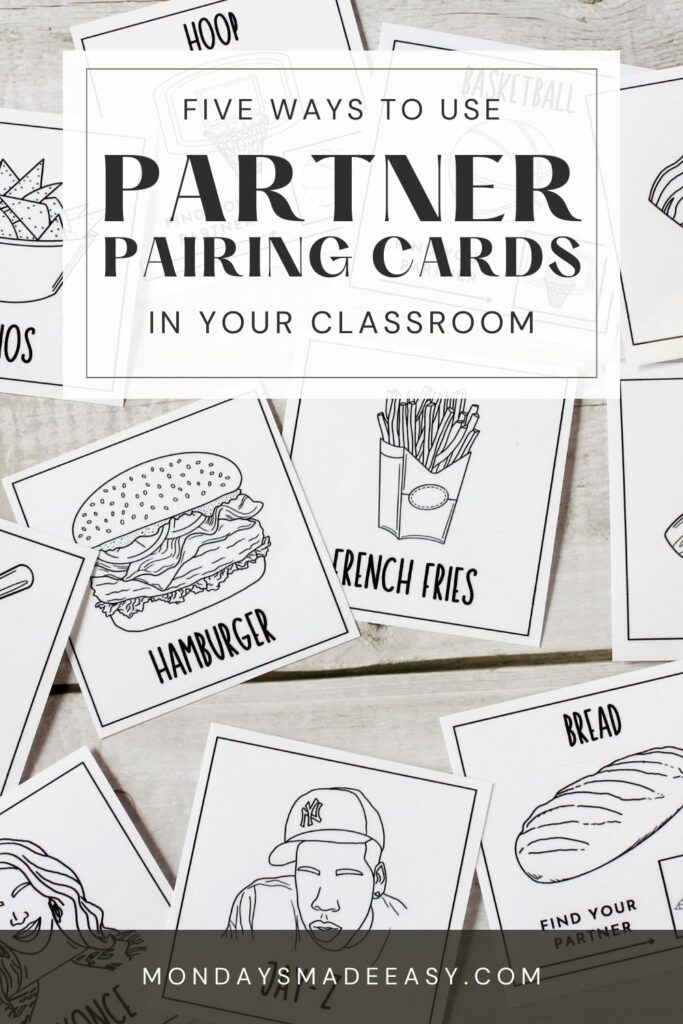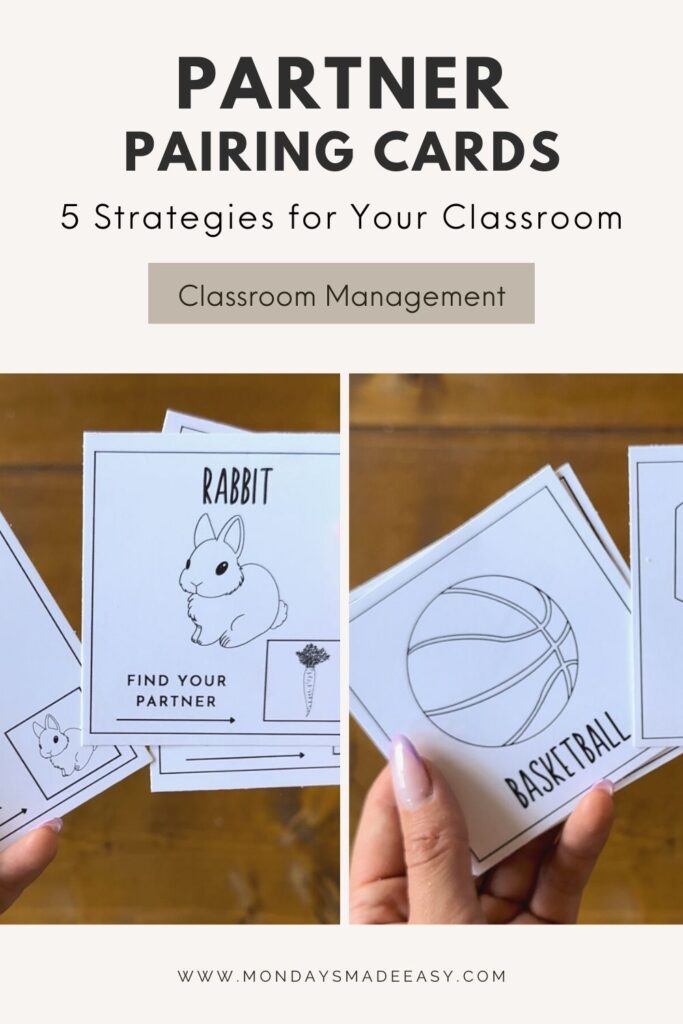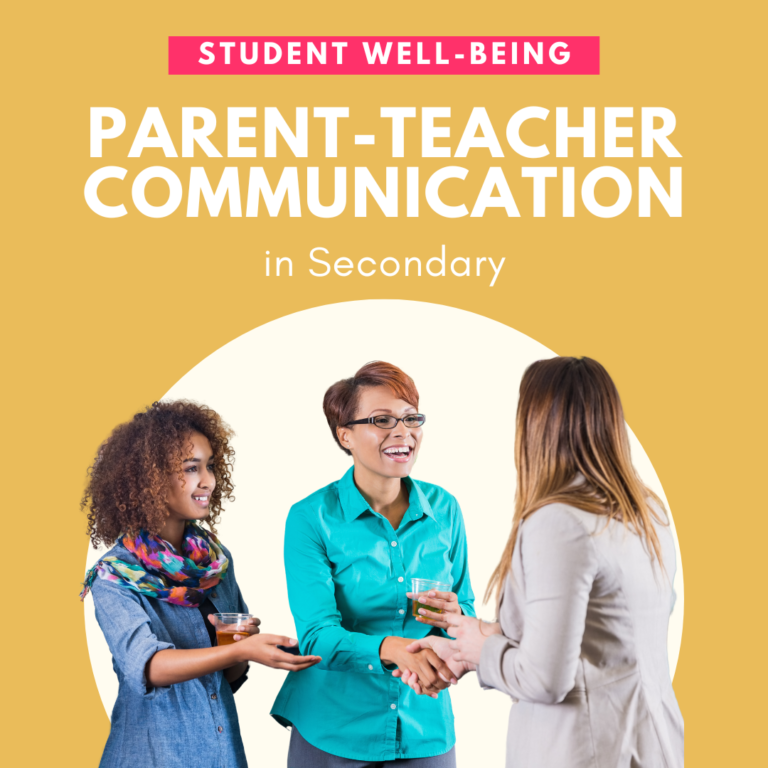There are many ways to use partner pairing cards in your classroom. This classroom management tool can be used to make seating plans, support vocabulary for English Language Learners, play icebreaker games, and more! In this blog post, I’ll show you the different ways that you can use partner pairing cards in your classroom.
Pairing cards encourage students to embrace collaboration and actively participate in activities. Whether you’re playing a simple “find your partner” icebreaker or facilitating something more complex, partner cards can boost engagement in your classroom. By leveraging partner pairing cards effectively, you can create a positive and inclusive learning environment that promotes meaningful student interactions.

Partner Pairing Cards for Classroom Activities and Assignments
One of the most straightforward uses for partner pairing cards is to randomly assign partners. When it’s time to form pairs, distribute the partner cards to each student. Students will find the person with the matching card by using problem-solving strategies. To form small groups, simply continue this process with pairs instead of individual students.
This strategy can be used for several cooperative learning activities, including think-pair-share, jigsaw learning, literature circles, and more. These can be used to facilitate the initial pairing and ensure that students interact with a diverse range of peers during the discussion and sharing stages.
To use cards for pairing, you’ll need a card deck featuring graphics of famous pairs. It also helps to include a trio in this deck. This partner pairing card deck includes cards to pair over 25 groups, including a group of three. The graphic design is suitable for older students. This deck even includes a differentiated version that indicates the matched pair. This is a great option for when you want to pair cards quickly without students having to guess.
“Find Your Partner” Icebreaker
Have you played the game “Headbanz” or “Head’s Up!” before? The “Find Your Partner” icebreaker is a bit like these games but with a twist! This icebreaker game activates students’ inquiry-based learning skills and gives them the opportunity to talk to their classmates. It’s the perfect icebreaker for teens!
To play, each student in your class will assume the role of the item or identity you provide them with. You can even have students make their own headband from paper and glue and then adhere their identity with velcro or tape. This role is kept secret, and the goal of this icebreaker game is for each student to communicate to find their matching partner. To do so, students can ask yes or no questions about anything other than the name of their classmate’s role: for example, they can’t ask “are you the sun?” or “does your name rhyme with bun?”
These partner cards are perfect for facilitating this “Find Your Partner” icebreaker game. This resource also includes a DIY headband template so that students can adhere their identity to their forehead.

Partner Pairing Cards for Seating Plans
Much like randomly assigning partners, pairing cards also work well to create seating plans. This approach to seating plans encourages social interaction and cooperation among students. It also promotes diversity and inclusion by using a randomized approach. Furthermore, when partners are seated with different classmates, they have the opportunity to collaborate and work with peers who bring different strengths and knowledge to the table.
To use matching cards for your seating plan, simply place a single partner card at each desk in your classroom. As students enter the room, provide them with a matching card and instruct them to find their desks. This classroom management tool be a great way to shake things up during times of the school year that feel a bit dull.
Vocabulary Flash Cards
If you teach English Language Learners, partner pairing cards can be a great tool to have on hand. This is because they double as vocabulary flashcards for popular words within the English dictionary. You can use the graphics on each flashcard as a visual cue to reinforce vocabulary. Students can quiz their knowledge by observing single-partner cards and trying to guess the word for the partnered pair. This approach to learning vocabulary is a stimulating way for students to challenge their knowledge.
Generally speaking, matching cards are a great tool for English Language Learners. This is because they offer both visual and text cues, making them a differentiated and inclusive mode of instruction. This card deck features graphic designs suited for older students and adult learners, making them an age-appropriate tool for ELLs in upper middle and high school.

Partner Pairing Cards for Assigning Student Jobs
Do you assign student jobs in your classroom? Partner pairing cards are a fun way to randomize these assignments. They can be utilized to assign student jobs by distributing different cards that represent specific responsibilities or tasks. By matching the cards, students can be assigned various roles, including class secretary, technology assistant, peer tutor, librarian, and materials manager.
Student jobs promote a sense of ownership and responsibility among students. They learn to work together, communicate effectively, and support one another. Using random pairing cards promotes fairness and equality and ensures that everyone has a chance to develop their skills and contribute to the classroom’s success.
Partner Pairing Cards: Tying it All Together
Partner pairing cards are a versatile and effective tool for creating meaningful interactions. They also help to foster a positive classroom environment. Whether used for random grouping, assigning student jobs, or as a “Find Your Partner” icebreaker, these cards promote social interaction and collaboration among students. By leveraging matching cards creatively, teachers can enhance student engagement, encourage peer learning, and cultivate a sense of belonging within the classroom.

To download my favorite pre-made partner pairing cards, click here.




